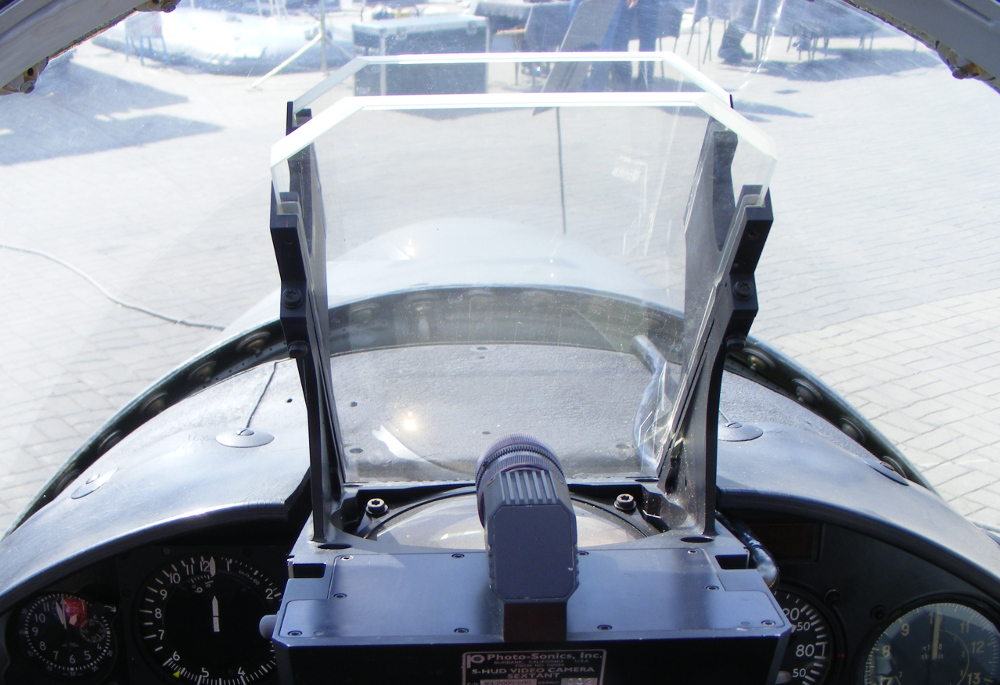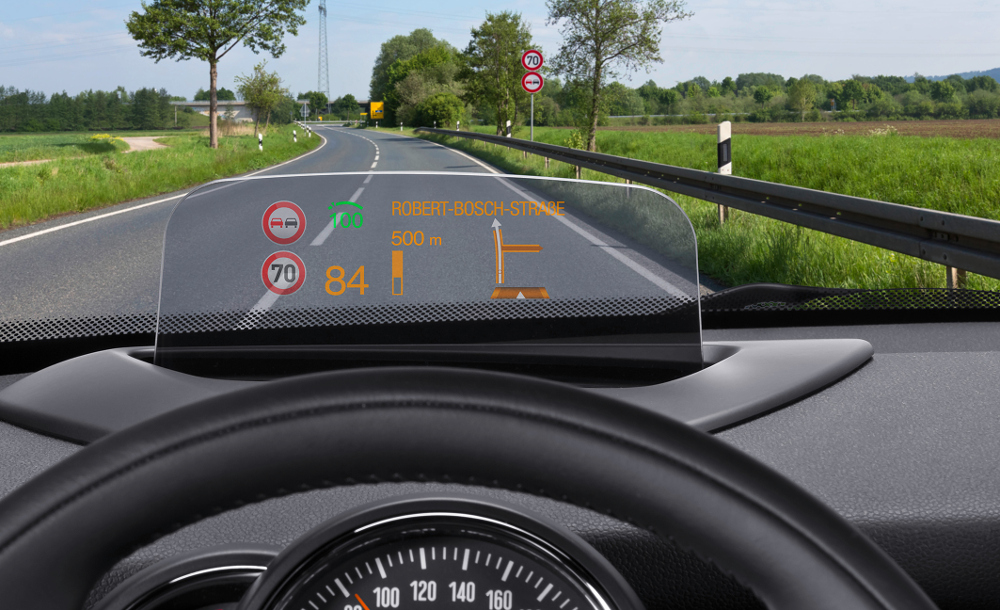Car HUD in general and WayRay Navion in particular
 Beginning in the late 80s, HUD (Head-up display) began to appear in high-priced cars - transparent displays that the driver watches while looking forward through the windshield. And even earlier (shortly before the beginning of the Second World War), in a rudimentary form - on airplanes, for displaying an aiming mark without parallax with further development to modern HUD.
Beginning in the late 80s, HUD (Head-up display) began to appear in high-priced cars - transparent displays that the driver watches while looking forward through the windshield. And even earlier (shortly before the beginning of the Second World War), in a rudimentary form - on airplanes, for displaying an aiming mark without parallax with further development to modern HUD.HUD technology has always been at the forefront of progress: from simple fixed sighting marks made of wire or painted on glass, to CRT displays, then LCDs and finally DLP and holographic ones, with laser backlighting. It was here, when all the necessary components and technologies became commercially available - WayRay appeared with its Navion product - 7 years ago it would have been simply impossible to do all this: there were no materials, no suitable lasers, or spatial modulators, and electronics would cost an order of magnitude more expensive.
Introduction Why do you need a HUD?
Actually, the goals both on airplanes and in cars are the same: when driving a moving vehicle, every millisecond distraction of the driver is worth its weight in gold and increases the chance of an accident.
When the driver looks at the dashboard - the driver needs not only to physically turn his eyes, but also to "refocus" on a close-lying object, to adapt to significantly different brightness.
HUD is attracted by the opportunity to display the image in front of the car and thus drastically reduce driver distraction time. And every millisecond saved is the lives of drivers and passengers.
')
Classic HUD implementation and its limitations
The 2 main parts of the HUD are the collimator and combiner. The collimator forms an image that appears to be located at some distance. The collimator is actually a kind of large eyepiece.
The combiner is in the first approximation a translucent mirror combining a real-world image and a virtual image formed by a collimator.
In the most primitive systems, the collimator can be just one lens or one spherical mirror - but the image quality of such systems is already bad enough to be noticed with an eye when driving at night. Why first of all at night? The pupil expands at night, and much more optical aberrations become visible. As a visual demonstration, you can show an image of the aiming mark in the simplest collimator sight (also a kind of rudimentary HUD):
On the left - on F11 (“small pupil”), on the right - on F2.8 (“big pupil”):

The next obvious limitation is that the angular size of the image remains small (about 4x2 ° for reasonable-sized automotive systems) and the distance to the virtual image is often also about 1.5-2.5m, which still causes refocusing. The distance has to be limited also because of its size - incomplete collimation allows the system to be made much smaller.
The small angular size of the image means that only a very small amount of information can be displayed normally — the speed, the type of the next maneuver and the distance to it — that’s probably all. The classic HUD implementation scheme with large collimators, mirrors and combineers takes up a rather large amount and therefore can only be installed in the factory. All this leaves room for the next step in improving HUD.
Review of existing technologies
Flat combine:
The classic "airplane" scheme - a collimator with large diameter lenses forms the image "away." This image is reflected from a flat translucent combiner - combined with the surrounding reality and is observed by the pilot. The main drawbacks are huge pieces of glass in front of the pilot, large size optics = all this is very difficult and expensive.

Source: Wikipedia - PZL TS-11 Iskra
The surface of the windshield as a combine:
According to this scheme, HUDs are made in most cars equipped with such a system at the factory. Here, the collimator has mirror elements, and instead of a combiner, there is a special coating on the windshield so that the reflection is only from one of its surfaces (otherwise the ghosting of the image will be visible).
Among the disadvantages of such a scheme is that the scheme should compensate for the actual curvature of the windshield, sufficiently large dimensions and still quite modest angular dimensions of the image being formed (about 4x2 °).

Source: Denso
Such a system in particular stands in some BMW models, and at the suggestion of journalists - they now like to compare us with it. The main differences are: the angular size of the image (with this classical system it is significantly smaller), the distance to the virtual image (2.5m against our 10m or more), the image is significantly lower than the road, and does not allow the elements of augmented reality to be drawn. navigation in the old-fashioned way, a schematic maneuver and distance to it - turn-by-turn navigation (of course, we also have such a mode, if it seems more familiar to someone).
Additional spherical combiner:
Trying to get away from the unpredictability of the shape of the windshield, and at the same time winning something in size - the first thing that comes to mind is to make the combiner be part of the collimator, i.e. perform part of the optical work on the formation of the image away, and not just reflect the light. In the simplest case, it is sufficient to make the collimator spherical (or, if it is a bit more complicated, with the off-axis segment of the paraboloid).
So (maybe it will be) aftermarket products made by Navdy, Pioneer, and the new generation of Bosch factory-built systems are made.
The main problem here - the driver now needs to look through 2 glasses + decreasing focal length (with the same dimensions) does not allow to have a large angular field.

Source: ee-times.com, Bosch
Without collimator (image "near"):
The most primitive systems: in fact, it is the screen, observed in the reflection of the windshield. If you do not stick a reflective film on the glass - the image will be doubled (since the reflection will be from the front and from the back surface of the windshield).
This system consists of flaws of a little more than full: the angular size of the image is tiny, the brightness of the image is insufficient for day trips (since glass reflects from 5% by itself to ~ 25% with a film with a proportional decrease in transparency). The image remains "close" - the eye will still have to refocus while translating the gaze.
However, there is a great advantage - such systems are the cheapest and easiest. Of the most famous examples are Garmin products, and just phones that are put upside down:

Source: techradar.com
Finally, the WayRay Navion approach is a holographic combine:
In Navion, part of the optical system is placed directly on the windshield of the car, and is implemented as a holographic optical element. This allows you to squeeze to the maximum everything that is possible from the overall limitations of the car - and gives the largest angular image size, which is only possible in projection systems with the same predetermined dimensions. By the area of the formed image is obtained from 4 to 10 times more than in the classical HUD. Also, due to the fact that the system does not suffer so much from the limitation of dimensions - we can display an image at a greater distance (in classical HUD, very often the rays are not fully collimated - the distance to the image is about 2.5 meters).
This sharp increase in the angular size of the image - allows you to display images that are combined with the real world: annotations to objects, and most importantly - draw a route directly on the road to make navigation as natural as possible.
This is no longer a fantasy, and since the summer of 2015, it is being tested in full on the streets of Russia and Europe . However, from a working prototype to a serial product - the amount of work is very large, so you cannot buy Navion yet.
Of the other features - Navion can also control the distance to the formed image. We are also now working on the use of this opportunity on the road.
The prototype of 2016 was made in the summer, a little more than 1300 parts:

When debugging in the office, it looks like this:

And on the road:

The version of 2017 will go to the masses - it will be somewhat smaller in size and more technological in production.
Some frequently asked questions:
For a start, briefly about the company. Now in WayRay more than 80 people work. Most of them work in the main development office - in Moscow. There are also offices in the USA, Switzerland and China. Over its history, the company has attracted more than $ 10 million investment. We have a full vertical of development: from mechanics, optics, electronics and drivers to top-level software for Android, design (and even people like this need to be done). We have our own pilot production, where, on CNC machines, we produce physical prototypes faster than China
3 years ago, in 2013, there was only an idea, and it was unclear how it can be implemented at all (and whether it is possible).
In 2014, we received the first holographic optical elements, and tested the performance of the idea on stationary stands. When it became clear that this could work - the speed of work and the number of people began to grow exponentially.
In 2015, we developed and assembled 2 iterations of the prototype on wheels, opened our holographic laboratory and pilot production workshop.
In 2016, the size was drastically reduced, and the system came substantially closer to how we see it in commercial operation. Also began active work directly with the automakers. They switched from modules to their fully electronic, capable of running our own Android assembly.
And will not your arrows accidentally close the world around and interfere with the driver?
In principle, any projection systems cannot close anything by definition - they cannot make the world behind the glass darker. Those. any interface elements in any case remain transparent. This principle immediately "reveals" the deception of photographs of any innovative projection clocks that have black magic projectors.
I don’t like the way the arrows move in your last year’s prototype
That's what he and last year. Iterations in the software are much faster than hardware, and we are constantly trying different interface implementations. There is of course the classic mode, with information about maneuvers.
Residents Skolkovo? Saw probably?
WayRay for more than 3 years of its existence did not receive state money, so there was nothing to cut. Nevertheless, we have tax privileges from Skolkovo (which allows, for example, not worrying to pay white salaries) and recently we finally managed to take advantage of the customs privilege - to import a Fourier spectrometer with compensation for a substantial part of customs expenses (although this is not so much money) . We also work with the Skolkovo Center for Intellectual Property - patent research and filing of applications.
When will Navion be available for purchase?
According to the plan - in 2017.
I hope this article was interesting to you, and there will be a reason to continue. Ask questions - and we will try to answer, if not crucified for the disclosure of trade secrets :-)
Source: https://habr.com/ru/post/397277/
All Articles